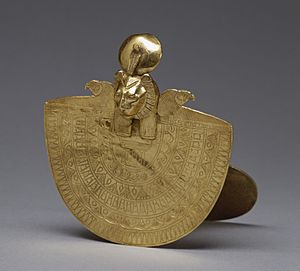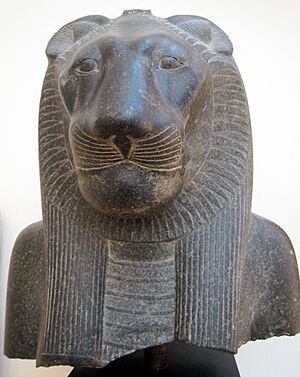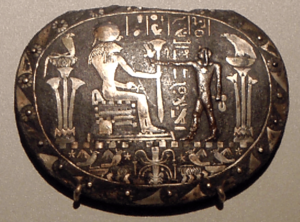Sekhmet facts for kids




In ancient Egyptian mythology, Sekhmet was a powerful goddess of fire and war. She had the head of a lioness and the body of a woman. Her name means "The Powerful One."
Sekhmet was married to Ptah, the god of healing. They were seen as a balanced pair. People believed that her breath created the desert. Sometimes, she was thought to be the sister of Bastet, a goddess who protected pregnant women and children.
Contents
What Sekhmet Looked Like
Sekhmet was usually shown with the head of a lioness and the body of a woman. She often had a sun disc on top of her head. Many historians think she came from Sudan, where lions were common.
When Sekhmet was sitting, she usually held the ankh, a symbol of life. When she was standing, she held a papyrus scepter. This scepter was a symbol of Lower Egypt.
Sekhmet's Powers and Role
The ancient Egyptians believed Sekhmet's breath was like the hot desert wind. Her body was seen as the intense glare of the midday sun. She was created when Hathor, another goddess, came to Earth to punish humans. Sekhmet became the destructive "Eye of Ra," a powerful solar goddess.
The Egyptians understood that the sun could bring life (like Hathor) but also death (like Sekhmet). Sekhmet used her power in a very strong and sometimes destructive way. People also believed that Sekhmet took over the sun at night and then gave birth to the moon each morning.
Why People Feared Sekhmet
People were afraid of Sekhmet because she had both healing and protective powers, but she could also be very destructive. The ancient Egyptians believed that the "Seven Arrows of Sekhmet" could bring bad luck. To protect themselves, they used many charms and spells.
They had a special prayer called the "Book of the Last Day of the Year." They would say this prayer over a piece of cloth and wear it around their neck. This was done at the end of the year, which was thought to be a dangerous time. On the first day of the New Year (Wep Ronpet), people would trade amulets shaped like Sekhmet. This was to keep the goddess happy and avoid her anger.
How Sekhmet Was Worshipped
Sekhmet was worshipped alongside her husband, Ptah, and her son, Nefertem. Her main worship center was in Memphis. Priests would say complex prayers to try and calm Sekhmet's rage.
One famous prayer was called "The Last Day of the Year." It was chanted while wearing a piece of cloth on one's head. This day was considered very risky because Sekhmet was thought to attack then.
Sekhmet was known as the "lady of life" and the "lady of terror." In one myth, Sekhmet went wild and thirsty for blood, causing terror across Egypt. Ra, the sun god, sent messengers to stop her. Eventually, Sekhmet saw love in everything and, in her happiness, she calmed down. She then transformed into Hathor, the goddess of love.
Sekhmet's Main Worship Places
Sekhmet's main worship center was in Memphis. When Amenemhat moved the capital of Egypt to Itjtawy, her worship center also moved. Because she was so similar to Hathor, special temples were built where people could worship both Sekhmet and Hathor.
During the rule of Amenhotep III, hundreds of statues of Sekhmet were set up. The bases of these statues often showed her fierce nature and violent myths.
See also
 In Spanish: Sejmet para niños
In Spanish: Sejmet para niños

